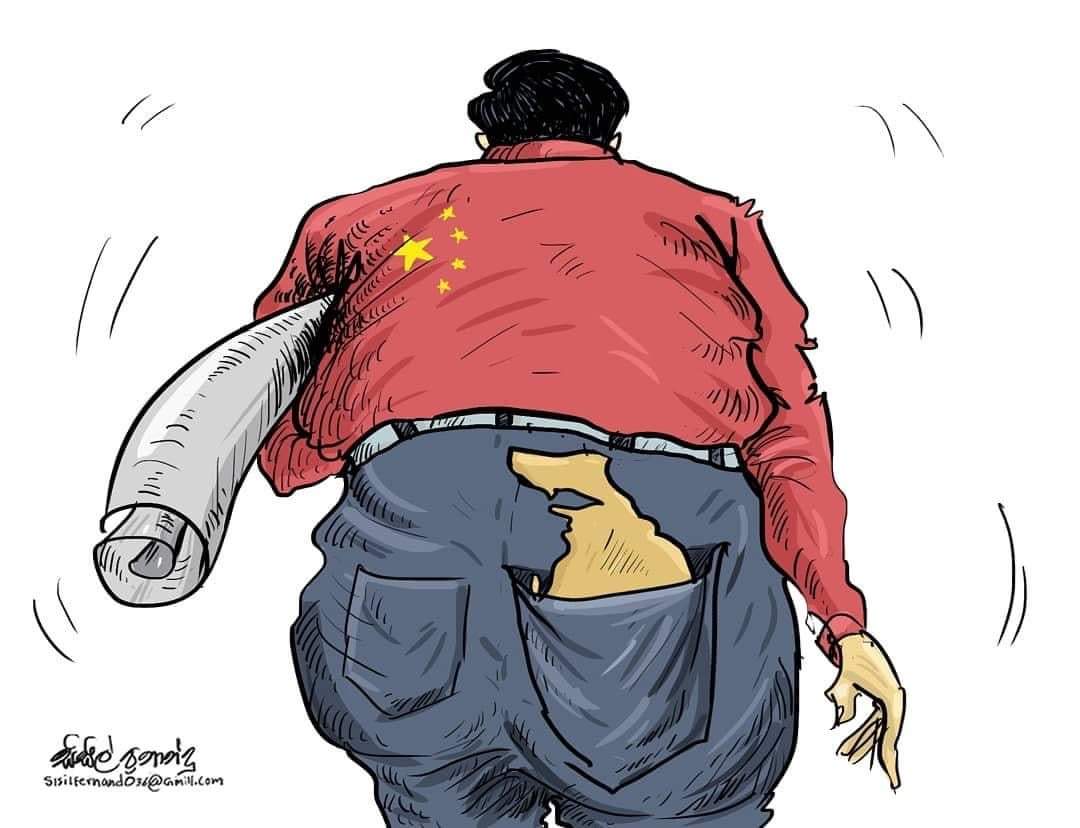In our last column published on 24 June titled “Are Sri Lankan banks failing the production economy?”, we wrote about how Sri Lanka’s banks have been failing the production economy due to their risk aversion and lack of lending towards productive sectors of the economy.
To briefly recap, we argued that the banking system plays a significant role in bridging gaps in financial resources and allocating resources in an economy. Lending plays an important role in balancing the structure of the economy and providing credit for capital formation in strategic economic sectors for sustainable and inclusive growth.
This week, we offer the contrasting example of China – an Asian economy which started out as one of the poorest in the world but has since grown to become the largest economy in the world in purchasing power parity terms, lifting 850 million people out of extreme poverty in the process.
Post-Covid stimulus
This analysis looks at data from six of China’s biggest banks which account for over 50% of the sector’s market capitalisation. The banks include Agricultural Bank of China, Bank of China, China Construction Bank Corporation, China Merchants Bank, Industrial and Commercial Bank of China, and Ping An Insurance.
Figure 1 depicts the total volume of loans and advances and their spread between personal and corporate. In 2020, the total stock of personal loans was $ 4.4 trillion, while the total stock of corporate loans was $ 5.7 trillion. This means that 44% of total loans and advances were for personal loans and the remaining 56% was corporate lending.
It is clear from the data that both corporate and personal lending have been increasing since 2017. However, corporate lending in particular has grown by 13% in 2020, perhaps as a response to the Covid-19 outbreak. As mainstream economic theory argues that such lending can be inflationary, it is important to understand how (if at all) this liquidity is being used to support production.
Personal loans and advances
Figures 2 and 3 depict the sector-wise composition of personal and corporate loans in 2020.
In the last four years, residential mortgages have comprised around 74% of the total loan stock. This is parallel to the 11% of corporate loans given to real estate, and 37% of corporate loans given to infrastructural sectors such as “Water, environment, and public utility management”, “Production and supply of electric power, heat, gas, and water, “ and “Transportation, storage, and postal services”. These trends reflect China’s rapid urbanisation and an over 90% home ownership rate which is higher than most advanced economies in the west. This synergy between personal and corporate lending has helped spur the development of the housing industry.
When compared to Sri Lanka, it is noteworthy that loans and advances for personal consumption (including credit card loans) account for 21% of total personal loans and less than 10% of the combined loan book of the six Chinese banks. When considering the loan books of the top eight banks of Sri Lanka, loans for personal consumption account for 25%. This indicates that a significant portion of Sri Lanka’s credit has been directed to consumption (most likely on imports), instead of growth enhancing capital formation.
Facilitating consumption while neglecting production can push a country like Sri Lanka further towards imports dependency, placing pressure on the exchange rate, and therefore the inflation rate too. Sri Lanka is dealing with the legacy and consequences of such policies today.
Corporate loans and advances
Five main sectors account for about 75% of corporate loans and advances in the six Chinese banks under study. These sectors are “Transportation, storage, and postal services”, “Manufacturing”, “Leasing and commercial services”, “Real estate”, and “Production and supply of electric power, heat, gas, and water”. China’s developmental goals of maintaining the production base and strengthening supportive and connective infrastructure are clearly reflected in this spread.
The vast amount of credit provided to infrastructure, combined with China’s low external debt and well developed infrastructure, indicates that the country has been largely self-reliant in terms of financing infrastructure. By contrast, Sri Lanka’s infrastructure development has historically been dependent on financing from foreign multilateral agencies like the World Bank and Asia Development Bank, or bilateral partners like Japan and China. Local private commercial banks’ lending for transport and energy infrastructure is virtually negligible compared to China. Meanwhile, Sri Lanka’s external debt to gross national income (GNI) is 69% compared to China’s 15%.
Long-term lending, long-sighted development
A stand-out feature of the loan books of Chinese banks is the relatively long maturity periods of the majority of loans and advances. Figure 4 shows the maturity period of respective loan stocks as at the end of the year 2020 of six major financial institutions in China. About 50% of the Chinese corporate loans are due after five years, and another 22% due in the one-to-five-year period. In other words, about 70% of loans and advances granted by Chinese banks are medium to long term. Businesses in China therefore enjoy patient financial support to expand the production and sustain growth.
By comparison, most loans and advances by Sri Lankan banks are concentrated in the five-year category. This tends to drive Sri Lankan businesses towards the pursuit of short-term profits, which in turn contributes to macroeconomic instability and poor economic planning. Short-term lending is fundamentally incompatible with policy goals of developing infrastructure and technology – both of which require patient, long-term financial support.
Running with a balance sheet mismatch
When banks start to fund long-term projects and offer grace periods and extended credit terms, a balance sheet mismatch is one of the major concerns of many treasury managers (Figure 5). Depending on the economic condition in the country, many risk-averse bankers resort to minimise this risk by encouraging short-term trade-oriented investments. However, bankers have a fiduciary duty to secure the depositor’s money and pay the return. So, how do China’s banks manage this mismatch while contributing to growth?
In total, we can see a significant net liability position in the on-demand category, and after the three-month category, it turns to a net asset position. Theoretically, these banks have funded long-term projects using short-term financing and therefore have critical liquidity risks. However, these banks manage their liquidity and continue to maintain loan books to fund strategic sectors. A comprehensive study on this area will help Sri Lankan banks learn strategies and best practices for risk mitigation and liquidity management.
Maintaining policy consistency
China’s domestic credit to the private sector by banks (Figure 6) has been increasing rapidly over the years and crossed 180% of gross domestic product (GDP) by 2020. By contrast, Sri Lanka’s risk-averse banking sector has a much lower leverage, with bank credit to the private sector amounting to about 50%.
One of the main contributors to the success of the Chinese economy, and the high volume of credit to the private sector, is policy consistency. Since 1978, China’s policy rates have been maintained in single-digit figures except on a few occasions (Figure 7). As the regulatory body of the banking system and the facilitator of economic development, People’s Bank of China (central bank of China) maintains low policy interest rates to reduce the cost of financing corporations and to direct resources to strategic sectors. Post-2000, the country’s exponential economic growth has been fuelled by low interest rates. The policy rate was reduced even after the Covid-19 outbreak, with an intention of heating up the economy. Strong economic policy consistency led by political stability in the country is the key to push the economy where it is now today.
Conclusion
Over the past decades, Sri Lanka’s policymakers have lacked a strategic plan to shift the economy from a services and consumption base to a manufacturing and production base. The few Asian countries that managed this transition did so through bold policy moves, including harnessing the banking system to re-engineer the structure of the economy. Countries like China, Singapore, South Korea, and to an extent even Bangladesh, have done what Sri Lanka has failed to do, thereby ensuring social stability and a higher standard of living for their people.
Sri Lankan policymakers and bureaucrats have to take a holistic approach to align all elements of the economy towards well-defined national economic objectives. When the Central Bank reduces the policy rates to increase liquidity, with the objective increasing investment and production, measures such as targeted lending must be put in place to ensure that commercial banks pump this liquidity towards strategic sectors.
Moreover, it is important that such policies are consistent and maintained for a period of time sufficient to allow investments to mature and generate profits.
(The writer holds a BSc. in Accountancy (Sp), FCA, ACMA, and MBA-PIM (SJP) and is Vice President (Finance, Research, and Strategic Development) at Econsult Asia, which is an economic research and management consultancy firm with an alternative development outlook)


